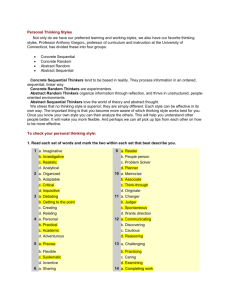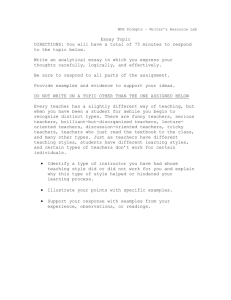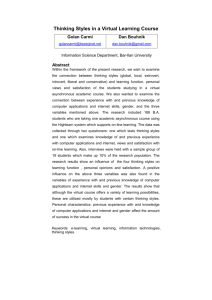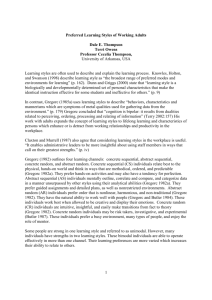Introduction to Cognitive Styles
advertisement
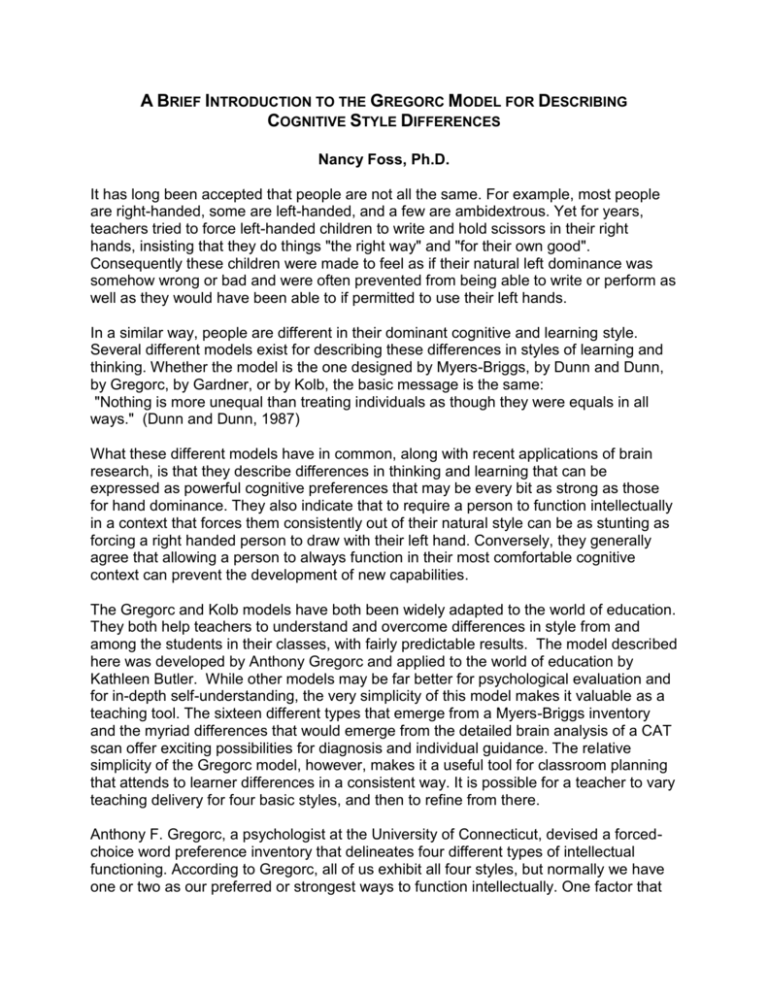
A BRIEF INTRODUCTION TO THE GREGORC MODEL FOR DESCRIBING COGNITIVE STYLE DIFFERENCES Nancy Foss, Ph.D. It has long been accepted that people are not all the same. For example, most people are right-handed, some are left-handed, and a few are ambidextrous. Yet for years, teachers tried to force left-handed children to write and hold scissors in their right hands, insisting that they do things "the right way" and "for their own good". Consequently these children were made to feel as if their natural left dominance was somehow wrong or bad and were often prevented from being able to write or perform as well as they would have been able to if permitted to use their left hands. In a similar way, people are different in their dominant cognitive and learning style. Several different models exist for describing these differences in styles of learning and thinking. Whether the model is the one designed by Myers-Briggs, by Dunn and Dunn, by Gregorc, by Gardner, or by Kolb, the basic message is the same: "Nothing is more unequal than treating individuals as though they were equals in all ways." (Dunn and Dunn, 1987) What these different models have in common, along with recent applications of brain research, is that they describe differences in thinking and learning that can be expressed as powerful cognitive preferences that may be every bit as strong as those for hand dominance. They also indicate that to require a person to function intellectually in a context that forces them consistently out of their natural style can be as stunting as forcing a right handed person to draw with their left hand. Conversely, they generally agree that allowing a person to always function in their most comfortable cognitive context can prevent the development of new capabilities. The Gregorc and Kolb models have both been widely adapted to the world of education. They both help teachers to understand and overcome differences in style from and among the students in their classes, with fairly predictable results. The model described here was developed by Anthony Gregorc and applied to the world of education by Kathleen Butler. While other models may be far better for psychological evaluation and for in-depth self-understanding, the very simplicity of this model makes it valuable as a teaching tool. The sixteen different types that emerge from a Myers-Briggs inventory and the myriad differences that would emerge from the detailed brain analysis of a CAT scan offer exciting possibilities for diagnosis and individual guidance. The relative simplicity of the Gregorc model, however, makes it a useful tool for classroom planning that attends to learner differences in a consistent way. It is possible for a teacher to vary teaching delivery for four basic styles, and then to refine from there. Anthony F. Gregorc, a psychologist at the University of Connecticut, devised a forcedchoice word preference inventory that delineates four different types of intellectual functioning. According to Gregorc, all of us exhibit all four styles, but normally we have one or two as our preferred or strongest ways to function intellectually. One factor that Nancy Foss Page 2 2/16/2016 makes this particular model so useful for teachers is Kathleen Butler’s systematic application of Gregorc's research for classroom instruction, called “Style Differentiated Instruction." Through her workshops and in her book, Learning and Teaching Style: In Theory and Practice (1986), Butler provides teachers with specific guidelines for teaching students of each dominant style and for bridging to students with styles that are not being addressed at a given time. She shows teachers how to vary and combine pedagogical approaches and activities in order to meet the style needs of all students more systematically. At Concordia College, I worked with colleagues in French, Spanish, and German to apply the Gregorc model in our foreign language classrooms. Data has been accumulating for over fifteen years, gathered both through large-scale student questionnaires across several language classrooms and through observation and student feedback in the college classes and at the Concordia Language Villages. It is now possible to describe distinct style differences among the four styles of the Gregorc model as they are expressed in the foreign language classroom, in proficiency development, and in student overseas immersion experiences. The following paragraphs present a short description of the model developed by Gregoc and the applications to teaching in general developed by Kathleen Butler, as adapted and synthesized by Nancy Foss. Further information can be found in the references listed in the bibliography. Applications to the world of second language acquisition and teaching are the work of Dr. Foss. THE GREGORC MINDSTYLES "Style is the set of outer behaviors that shows an individual's underlying mental strengths and capacities. Style serves as a personal frame of reference and a revelation of aspects of one's essential self. When we address learning style, we consider the learner's unique combination of inner strengths, to encounter, access, a process information in certain ways. to relate to his/her immediate world from certain view-points, and to define her/himself as a learner." (Butler1990, p. 1) The Gregorc Mindstyle model describes four cognitive styles for perceiving, processing, and ordering information. The model describes these styles according to four variables: concrete, abstract, random and sequential, creating four styles: Concrete Sequential (CS) Abstract Sequential (AS) Abstract Random (AR) Concrete Random (CR) Nancy Foss Page 3 2/16/2016 CONCRETE RANDOM SEQUENTIAL ABSTRACT We all need the abilities of each of these styles, but most of us have a style preference, just as we have a preferred hand for writing. The following sketchy profiles describe learners who have a style dominance in each of the four styles. It is important to emphasize, however, that each profile characterizes a person with a single, very dominant preference for that style. Most of us have a more mixed preference pattern. A teacher who plans to appeal to all four styles throughout a unit or a lesson will not only be meeting style preference needs, but will also be challenging students to develop cognitive strengths outside of their dominant style. The descriptions that follow are based on the works of Gregorc and Butler and on Nancy Foss’s work at Concordia College applying this model in the foreign language classroom. CONCRETE SEQUENTIAL This style dominates the traditional classroom methodologies. People with this dominant style constitute 30% of the population, but, according to Butler, this style dominates elementary and secondary education in the United States. She reports that 55% of the elementary and secondary teachers of this country demonstrate this as a dominant style, and the proportion among school administrators is even higher. IN GENERAL: People of this style like clear structure with clear directions and deadlines. They prefer to be told what to do and how to do it. They are gifted at organizing according to an established or traditional pattern and are good at maintaining that organization. They like to collect discrete concrete facts or objects, classify them, chart and report on them. IN THE CLASSROOM They prefer a world where there is a clear hierarchy, where there is a right answer and a wrong answer, and where tidiness and organization are rewarded. Nancy Foss Page 4 2/16/2016 FOREIGN LANGUAGE In foreign language classes these students frequently prefer to write the foreign language rather than to speak it. They have a concern for accuracy and a fear of error that slows down spontaneous use of the language and oral skills. They often do well at novice level tasks such as drills and vocabulary memorization These are the students who want you to translate everything. “What is the REAL word?” Resist and reassure them. They prefer written exercises where there is one right answer They tend to prefer to relate to the written language rather than the spoken language. They dislike role plays and group activities They tolerate partner activities better than group activities and are more willing to speak in the target language in structured paired activities than in larger groups. These students are among the most stressed by an immersion situation or in a content-based class. Highly structured scaffolding and support with written material that is sequentially organized can lower their affective filter, along with an assurance that it is normal for them to feel stressed under those circumstances and that it won’t affect their grade unless they refuse to participate. ABSTRACT SEQUENTIAL This is the least common style, being represented by only 8% of the population and only 8% of the teachers in elementary and secondary schools. The style has a disproportionate influence on education in general, however, since members of this group, who like to learn from books, write many of the textbooks. People who have this as their dominant style are more frequently represented among National Merit Scholarship finalists and lawyers that in the general population. IN GENERAL People with this dominant style are a small proportion of the population, but they are highly respected for their intellectual prowess and vocabulary. They tend to organize thoughts around themes, with thematic piles on their desks or shelves. Books are a major part of the world of the person who has a high Abstract Sequential style, particularly reference and non-fiction books. IN EDUCATION People of this style are highly independent learners who are gifted at analytical thinking, who like to research independently, to hypothesize, and to debate different sides of the same issue. This style tends to like lecture-style instruction with some, but not too much, practice. Nancy Foss Page 5 2/16/2016 They prefer a learning environment where a high degree of independence is permitted and where academic excellence is rewarded, where the rightness and wrongness of an answer is always open for debate. FOREIGN LANGUAGE In the foreign language world, these are individuals who can actually buy and learn from a teach-it-to-yourself language program. They would tend to prefer to learn grammar rules and practice a few times, and they usually lead with reading and writing rather than speaking skills. Because of their love of opinion-stating and debate, individuals of this style who are at the novice or intermediate level tend to be frustrated with the limitations of their expressive skills. On the other hand, once they have reached an advanced level of speaking or writing, individuals with a high Abstract Sequential tendency will probably have little difficulty moving up to superior level speaking and writing. Other styles may be cognitively at a disadvantage for evolving into superior speakers, but this style already enjoys the superior functions of hypothesizing and stating and defending of opinions. Abstract Sequential dominant learners tend to dislike group activities and role plays. They tend to get impatient with too much repetition and with TPR methods. The advantage of content-based instruction for students of this style is that they would be inherently interested in the content and would respond well to opportunities to do additional reading and reporting to the class instead of playing “silly games”. ABSTRACT RANDOM This is the most common style in the general population at 40% and is less well represented in the teaching profession, where they are only 25% of elementary and secondary teachers. IN GENERAL People with this dominant style are heavily influenced by the personal pleasure they derive from a situation, be it aesthetic or emotional. They tend to be extremely attuned to the people and the emotional environment around them. They are often artistic. IN EDUCATION: The most important thing for a teacher to do in order to effectively educate students with this dominant style is to communicate that you like them. If they feel that you like them, they will make enormous efforts to please you. If they feel that you are cool toward them or actually dislike them, it is almost impossible for them to learn in your classroom. In general individuals who have a high Abstract Random style are easily discouraged in the highly sequential world of the typical American classroom, Nancy Foss Page 6 2/16/2016 both because their dominant style puts them at a learning disadvantage and because they are often criticized for their messiness, lack of attention to detail and failure to follow directions. Anxious to please, they do best when they receive emotional support, and are allowed to learn through storytelling, pretending and creating. They prefer a world that is warm and beautiful, where others are sensitive to their feelings, and where sensitivity and artistic creativity are valued. These students can often function better if taught to use a variety of colors for taking notes and organizing information. FOREIGN LANGUAGE Of all students, these are the ones who reported being attracted simply to the idea of studying another language. Unless they are highly introverted, people of this dominant style will lead with speaking and will work at imitating the accent and sounds of the language. In writing, these students will struggle for accuracy, but may be very expressive writers if you can follow their creative spelling and grammar. In terms of classroom activities, this is the group that likes group activities of all kinds. They do, however, report liking pair activities almost as well as group activities, so it is recommended that teachers maximize the use of pair activities, which are more attractive to the other three styles, and to save the group activities for special projects. Role plays are another activity that this group reports really enjoying, unlike the two sequential styles. Simulation games are a great way to allow for this style to role play while other styles may avoid identification with a character and play the game in the third person. High Abstract Random dominant individuals like stories, songs, TPR, and classroom celebrations. CONCRETE RANDOM This is the dominant style of approximately 22% of the population, but only 12% of elementary and secondary school teachers. IN GENERAL Most famous inventors were probably dominant or strong in this style, which is best known for creative problem solving and solving mysteries. Typically, individuals of this style are divergent thinkers who dislike being told what to do and how to do it. Directions for assembling a purchase, for example, are only for reference if they can’t figure it out on their own. On the other hand, people with this dominant style do not at all mind taking charge in an emergency and telling other people what to do and how to do it. Often considered to be “trouble makers” in highly structured environments, individuals with this dominant style will be valued for this ability to rise to the occasion in an emergency. Nancy Foss Page 7 2/16/2016 IN EDUCATION People of this dominant style are often very uncomfortable in the highly structured and directive atmosphere that is typical in American education today. They in turn can make traditional teachers uncomfortable either by their divergent thinking (there is more than one “right” answer or way to do it.) or by their tendency to ask questions (The most frequent question being, “Why?”). According to Kathleen Butler, this style is the most likely to drop out of school (as a way to solve the problem of their discomfort in school.) Students with dominant Concrete Random style will thrive in an atmosphere that permits individual problem solving, group brainstorming, simulation games and competitive games. They prefer a world where they are not told what to do, but have an opportunity to learn by asking questions, where they can try to figure things out on their own, and where the ability to provide leadership in crisis situations is rewarded. FOREIGN LANGUAGE In learning a foreign language these students have great skill at circumlocution and at making the language work for communication somehow, but they often butcher the language in the process, always trying to make it do more than they know how to do. They prefer to speak rather than to write and have lingering accuracy problems. TPR, games and pair activities are powerful teaching tools for students with this dominant style. HOW TO USE THIS INFORMATION IN UNIT AND LESSON PLANNING: Kathleen Butler, in her work applying the Gregorc model to education, advocates that teachers systematically try to meet the style needs of all four styles in their classes. She advocates the following ways to do this: 1. VARIETY: Throughout a unit and a lesson, students are presented with a variety of assigned tasks appealing to different styles, one after another. 2. CHOICE APPROACH: Students are given a choice of activities at the same level of difficulty, one geared to each style. Nancy Foss Page 8 2/16/2016 3. BRIDGING Another important concept in Butler’s work is that of “Bridging,” or attending in some way to the needs of those whose style preferences are not being met by the current classroom activity. Bridging is an important tool for lowering the affective filter. These are some examples of bridging strategies: It may be a matter of simply reassuring a student that you know this activity is not their favorite, but they can learn from it, and later they will have a chance to do part of the lesson in a way that they will like better. Allow students to talk out loud to brainstorm prior to a writing assignment, or permit them to make notes to help in a speaking activity. Adjust the words of affirmation and encouragement that you use to the expressions that seem to be the most appreciated by the student. Be attentive to providing clear directions, with examples and exact criteria and details. These will help sequential students to be more comfortable with the games, simulations, and creative activities that random styles thrive on. Use partner work regularly, since it is accepted by all the styles to some degree. “MAGIC WORDS” OF AFFIRMATION AND MOTIVATION: The Second Language Acquisition model used in these materials describes the emotional barriers to learning. If a student is feeling uncomfortable, the “affective filter” goes up and screens out whatever is being presented. It is my contention that different styles have different kinds of “affective filter”. All styles tend to have a high affective filter when the input is way above the level of language that they can easily understand. The CS style person is most likely to feel anxiety about an immersion experience and oral work, while these would be comfortable for a student with a high AR style, who may feel enormously stressed by a writing task. Students who are working outside of their comfort zone, in a style that is not a good fit for them, often find that the affective filter is rising and interfering with learning. At such a moment, teachers need to use words of affirmation and understanding to help prevent frustration. Because individuals with different cognitive styles value different qualities in their lives, their environments, and their activities, they also respond in different ways to words of motivation and praise. When there is a mismatch of the words chosen by the teacher and the way they are received, the intended message is lost. The words below will communicate most clearly with each of the style preferences listed. It would be a good idea to copy the following chart and write in a translation of each expression in the target language you teach. CONCRETE SEQUENTIAL • This is the correct way.. • Here are the directions. • Do it right! • Correct, Good Nancy Foss Page 9 2/16/2016 ABSTRACT SEQUENTIAL An excellent idea! Understand the issues... Here's a book about... This is superior work. ABSTRACT RANDOM Let's create a... Let me tell you a story. That's super!!! Fantastic! CONCRETE RANDOM Solve this mystery! Can you help with a problem? Let's play a game... That's great! BIBLIOGRAPHY Butler, Kathleen. Learning and Teaching Style: In Theory and Practice. Columbia, CT: Learners' Dimension, 1986. Butler, Kathleen. "An Introduction to the Gregorc Model of Mindstyles." Presentation Guide I, The Learner's Dimension, 1990. Dunn, Kenneth, and Rita Dunn, “Dispelling Outmoded Beliefs about Student Learning" Educational Leadership, March, 1987. Gregorc, Anthony F. An Adult’s Guide to Style. Maynard, MA: Gabriel Systems, Inc., 1982. Gregorc Style Delineator (intended for adults) Order online from: http://www.gregorc.com/instrume.html
